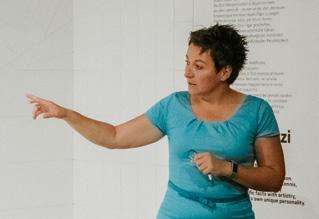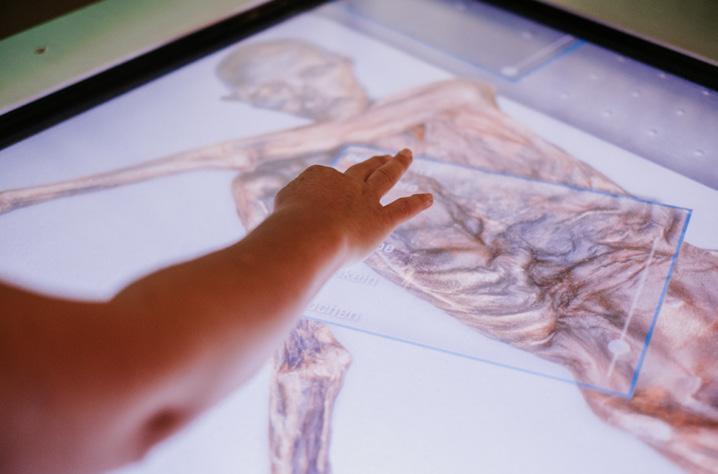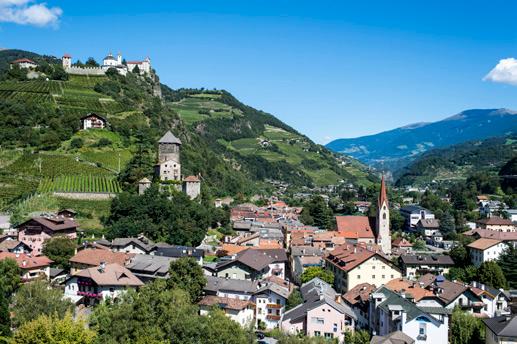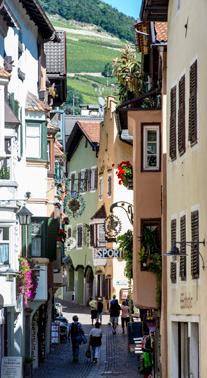
9 minute read
Was the Iceman from Eisacktal Valley? An interview discussing “Ötzi
The Museum
+ The permanent exhibition at the South Tyrol Museum of Archaeology is all about Ötzi, the Iceman. On three floors, the exhibition displays both the mummy itself and other finds: clothing and equipment.
Advertisement
+ In addition, visitors learn the details of how Ötzi was found, the complicated recovery mission, the determination of the mummy’s age, and the sophisticated conservation method.
+ The museum also has a section dedicated to how our Copper-Age ancestors lived their daily lives. One of the highlights of the exhibition is the lifelike reconstruction of the Iceman.
+ South Tyrol Museum of Archaeology, Bolzano/Bozen: Via Museo 43, phone +39 0471 320 100, Tuesday to Sunday, 10 am to 6 pm, adult ticket 9 EUR.
www.iceman.it
Ötzi
In 1991, mountaineers at the Schnalstal glacier stumbled upon Ötzi, the ice mummy. The find soon turned out to be sensational: the mummy was more than 5,300 years old and had been naturally preserved in the ice. Thorough examination led to the discovery of an arrowhead in the left shoulder blade: the man had been murdered! When he was alive, Ötzi was approx. 1.60 metres tall and weighed 50 kilos. He had dark hair of medium length and was 45 years old when he died.
Interview

Was the Iceman from Eisacktal Valley?
Many secrets still wait to be revealed about Ötzi, the Iceman, a more than 5,000-year-old mummified body found on a glacier. Angelika Fleckinger, director of the South Tyrol Museum of Archaeology, talks to us about stunning new findings, Eisacktal Valley at the time of Ötzi, and why the Iceman’s mouth tells us a lot about where he came from.
Interview — LISA MARIA KAGER Photos — MICHAEL PEZZEI
“Ötzi isn’t just an item of research, he was a human being. We should treat him with respect.”

Dr Angelika Fleckinger
Born in 1970, she read pre- and early history, art history, and classic archaeology at the University of Innsbruck. From 1998 to 2004 she was the coordinator of the South Tyrol Museum of Archaeology in Bolzano; in January 2005, she took over as director. Her publications include “Ötzi, the Iceman” and “Ötzi 2.0”.
You have been with the South Tyrol Museum of Archaeology for more than twenty years, and thirteen years in your current role as director. For you personally, what is the most stunning discovery of all the research done on Ötzi during this time? Definitely the arrowhead found in Ötzi’s shoulder. This soon pointed to the fact that he was murdered, and we had to completely rewrite his story. The Iceman, as he is known, is no ordinary exhibit. The visitors and employees at the museum and the researchers see him as a person, someone who was living and breathing. Ötzi isn’t just a historical artifact, he was a human being. We should treat him with respect.
Over time, numerous samples have been taken from Ötzi’s body to uncover new facts about his life. This is how researchers found that he probably came from Eisacktal Valley. How come? In 2003, the Austrian researcher Wolfgang Müller took a tiny sample of Ötzi’s tooth enamel to examine strontium isotopes. In humans, up to age four, isotopes from our natural environment enter the dental enamel and are preserved there for our whole lifetime. These deposits allow us to determine where someone spent their childhood. Soil samples were taken all across South Tyrol to determine different isotope levels. The results suggest that Ötzi spent his childhood in an area with crystalline soil like you would find in the upper Eisacktal Valley. Soil samples from Velturno/Feldthurns showed the highest match.
Did Ötzi spend part of his life in other areas of South Tyrol? The isotopes in his thigh bones indicate that he spent at least the last couple of years in Val Venosta/Vinschgau. And we know that people at the time sometimes moved to other areas. Many women, for example, spent their lives far from where they were born, because they got married or lived in a relationship.
Did Ötzi’s family live alone? No, they lived in a small, village-like settlement. We do not know a lot about social structures back at the time, but one thing is for sure: South Tyrol was far less populated than it is today.
Why was Eisacktal Valley an area of settlement? People tended to choose flat terrain for their settlements to allow for livestock and crop farming. And water sources played an important role, too. Eisacktal Valley is very steep, but it gets more hospitable at midheight, for example on the Villandro/Villanders and Velturno plateaus above Chiusa/Klausen. These were most likely good places to live even in Ötzi’s day and age.
Also for food? Yes, that’s for sure. The diet during the Copper Age mainly consisted of self-bred livestock and farmed
The results suggest that Ötzi spent his childhood in an area with crystalline soils like those found in the upper Eisacktal Valley.

crops, but hunting and gathering played an important role, too. Sheep, goats, and cattle were probably sent to high-alp pastures in summer. Just like the farmers today, people used to make hay during that time, which they needed to feed their livestock in winter.
What is left from the Iceman’s age here in Eisacktal Valley? There are some finds from the Neolithic period. For example, the Plunacker archaeological site in Villandro and the Tanzgasse ritual place in Velturno—both of them are open to the public. At archaeological sites all over South Tyrol, stone statues known as menhirs were found, including at Bressanone-Tecelinga/Brixen-Tötschling. One of the stones from this archaeological site, which is supposed to depict a male body, is now on display at the South Tyrol Museum of Archaeology. When taking a closer look, you will find weapons and daggers engraved in its hard surface.
Which role did cults and rites play in Ötzi’s time? We are sure that the people of the time had some sort of religious beliefs. Unfortunately, there are no written records, so it is impossible to know exactly what religion looked like back then. Ancestor worship probably played a crucial role. And religion was strongly tied to

social life, seeing as the original purpose of religion is to regulate social communities. Just think about the Ten Commandments: they are essentially a rulebook, a guideline for a well-functioning society. Such rules for community life probably existed back in the Iceman’s day, too. The statues that were discovered either symbolised gods, or—and that is even more likely— influential ancestors.
And what about Ötzi’s descendants? Do they still live here? Ninety-seven percent of Ötzi’s genome have been sequenced. His female genetic line is extinct, but Ötzi’s DNA from the Y chromosome can still be found. This means that there are several people from the same genetic group as the Iceman. However, this does not mean they are direct relatives. These people now mainly live in Sardinia and Corsica. In continental Europe, the various genetic lines have mingled to a far higher degree. But nobody can rule out being related to him. We often receive emails from people who claim they belong to the same genetic group as Ötzi, especially from the US, where DNA testing has become hugely popular. People get tested on their own accord to learn more about their genetic history and genetic predisposition.
The diet during the Copper Age mainly consisted of self-bred livestock, but the people were also hunters and gatherers.



Research on Ötzi, the ice mummy, has been going on for more than twenty-seven years now. What’s left to be discovered? We have seen a significant evolution of research over the last couple of years, and I’m sure this is going to continue. Every year, we receive half a dozen research requests from all over the globe. The Iceman is truly unique. The glacier ice perfectly preserved his body— unlike the mummies in Egypt, where mummification was artificially induced by chemicals or drying. Ötzi is highly valuable for research and helps us gain a more thorough understanding of what life was like in his day and age.
What are the questions you would like to find an answer to in the near future? I would like to know even more about what he did during the last days of his life. What exactly happened to him? Why was he murdered? There are so many fascinating questions.
A menhir from Bressanone-Tecelinga is now on display at the Museum of Archaeology in Bolzano.
Discover an Artist’s Town
Shopping, indulgence, and culture in Chiusa/Klausen

Little Chiusa, situated in the lower Eisacktal Valley, was selected as one of the “Borghi più belli d’Italia”, i. e. one of Italy’s most beautiful historic towns. The mediaeval flair of its alleys and striking town houses with their narrow, beautifully coloured façades has always been a magnet for artists and poets. The Säben Mountain towering over the valley is home to what was once one of the most important episcopal sees of Tyrol. Säben—now a Benedictine convent—as well as the Gothic churches in town, the Capuchin monastery, and the mighty Branzoll castle are testament to the town’s history as a mediaeval customs station. Approx. 2,500 people live in Chiusa, nestled among a picturesque landscape of vineyards and chestnut groves that have seen centuries of active farming. The town was Albrecht Dürer’s source of inspiration for the copper engraving titled “The Great Fortune”, depicting the Greek goddess Nemesis balancing on a sphere over Chiusa.
In this modern day and age, numerous little owner-run shops and trendy independent boutiques attract shoppers to stroll along the historical old town streets. Check out the colourful flower vendors, find traditional and modern craftwork, shop top-of-the-range women’s fashion, and explore native, regional, and fair-trade products. The inns situated alongside Chiusa’s winding alleys have been around for centuries, serving guests back when the main road from Brennero/ Brenner to the south still crossed right through the village. Today, the town inns offer plenty of home-made, traditional Alpine dishes from South Tyrol as well as Italian-Mediterranean specialities.
With its colourful historic town houses and numerous small, owner-run shops, Chiusa’s old town offers many opportunities for strolling and shopping.
Store opening hours
+ Monday to Friday, from 9 am to 12 pm and from 3 pm to 7 pm Saturday 9 am to 12 pm
www.klausen.it/shopping
Museum of Chiusa
+ The museum is open from 24 March to 3 November from Tuesday to Saturday, 9:30 am to 12 pm and 3:30 pm to 6 pm. The Museum of Chiusa is closed on Sundays, Mondays, and public holidays.
www.museumklausenchiusa.it
Free guided tours of the town
+ Every Tuesday in July, August, and September (in German) Every Monday in July and August (in Italian) Meeting point: Chiusa Tourism Office, Piazza Mercato 1, phone +39 0472 847 424











